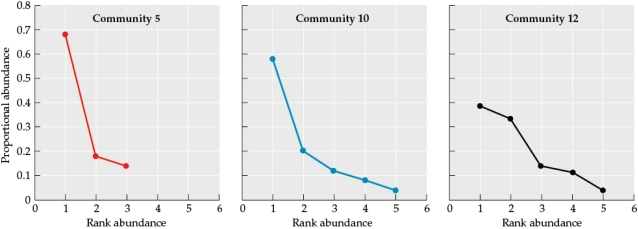Refer to the table and figure.
 Figure 3
Figure 3
 Suppose you are researching an ecological community in a new study area. You divide your study area into quadrats and sample one quadrat a day to determine the species that occupy the area and how many individuals of these species are present. Assume that by the end of your sampling efforts, you have identified all of the species that occur in the study area. Use the proportional abundances of species that you calculated and graphed in Table 4 and Figure 3 to answer the following questions:
Suppose you are researching an ecological community in a new study area. You divide your study area into quadrats and sample one quadrat a day to determine the species that occupy the area and how many individuals of these species are present. Assume that by the end of your sampling efforts, you have identified all of the species that occur in the study area. Use the proportional abundances of species that you calculated and graphed in Table 4 and Figure 3 to answer the following questions:
a) How are the roles of foundational species and keystone species defined? What are the similarities and differences in terms of how each functions in its community?
b) Based on just the abundance data in Table 4, create a new table (this will be referred to as Table 6) showing all of the species that could be considered foundational species or keystone species in each community.
c) What two types of additional information would you need to determine whether these species were indeed foundational species or keystone species? How could you obtain this information? Based on the definitions of foundational and keystone species, how would you use this information to determine whether the species were foundational or keystone species?
Definitions:
Japanese Proverb
Traditional sayings originating in Japan, often encapsulating moral lessons, wisdom, and cultural values conveyed through metaphorical or allegorical language.
Sticks Up
The act of defending or standing up for someone or something, often in the face of criticism or opposition.
Hammered Down
A colloquial expression meaning to solidify, confirm, or enforce something with emphasis or authority.
Drive For Mastery
The innate or acquired desire to improve one's skills, knowledge, or competence in a particular area.
Q10: Which pattern of population dynamics best describes
Q23: Which statement about malaria and the life
Q34: There are two pairs of competing species
Q35: Sequoias, considered by many to be the
Q39: A frog pond contained 27 adults at
Q49: Which statement comparing island biogeography to mainland
Q53: Which statement about logistic growth is false?<br>A)
Q58: Which criterion is most important in determining
Q65: Why is the barnacle Chthamalus found only
Q68: Which of the following is an advantage